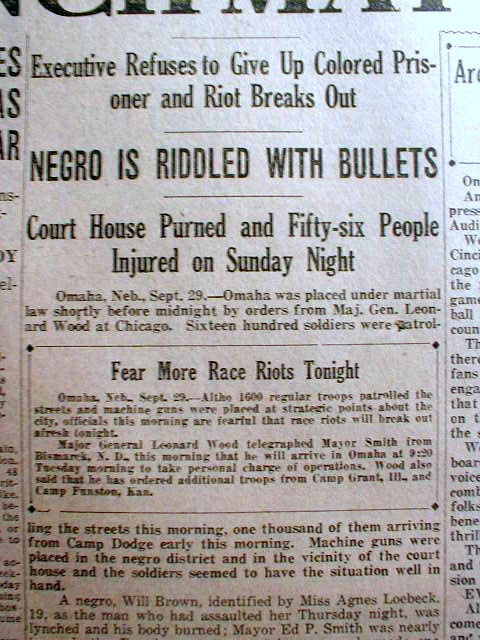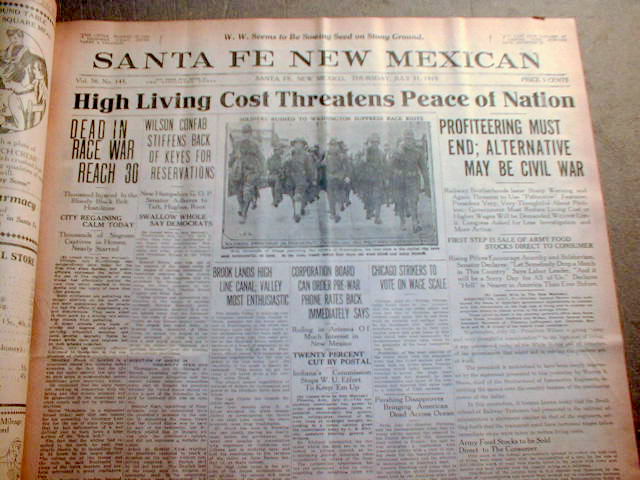gangs and the Chicago riot
As part of the background of the Chicago riot, the activities of gangs of hoodlums should be cited. There had been friction for years, especially along the western boundary of the area in which the Negroes mainly live, and in the spring just preceding the riot. They reached a climax on the night of June 21, 1919, five weeks before the riot, when two Negroes were murdered. Each was alone at the time and was the victim of unprovoked and particularly brutal attack. Molestation of Negroes by hoodlums had been prevalent in the vicitiy of parks and playgrounds and at bathing-beaches."
Gangs and their activities were an important factor throughout the riot. But for them it is doubtful if the riot would have gone beyond the first clash. Both organized gangs and those which sprang into existence because of the opportunity afforded seized upon the excuse of the first conflict to engage in lawless acts.
It was no new thing for youthful white and Negro groups to come to violence. For years, as the sections of this report dealing with antecedent clashes and with recreation show, there had been clashes over baseball grounds, swimming-pools in the parks, the right to walk on certain streets, etc.
Gangs whose activities figured so prominently in the riot were all white gangs, or "athletic clubs." Negroes hoodlums do not appear to form organized gangs so readily. Judges of the municipal court said that there are no gang organization among Negroes to compare with those found among young whites." (11-12)
Many of the white gangs came from the Stock Yards, and even the police said they could get little information from residents about the activities of their gangs. The report singles out the "Canaryville bunch" and "Hamburgs" as particularly tough and involved in the riot. Richard J. Daley, later mayor of Chicago was a member of the club at the time and was its president in 1924. The Hamburgs were sponsored by Bridgeport Alderman Josepth McDonough who incited whites with incendiary statements of "bombs exploding" and warnings that Blacks were "armed" and invading (28). Daley always refused to comment on whether he was involved in the rioting.
The worst of the white gangs were "
Ragen's Colts," a gang whose turf extended from Cottage Grove to Ashland and from Forty-third to Sixty-third Street. The gang was sponsored by Cook County Commissioner Frank Ragen. Gang members boasted that they were "protected" and "tipped off" by police. The Colts even broke into a police station at 47th and Halstead and stole evidence, including firearms.
Ragen's Colts and other "athletic clubs" were targeted by the Grand Jury, whose report said:
"The authorities employed to enforce the law should thoroughly investigate clubs and other organizations posing as athletic and social clubs which really are organizations of hoodlums and criminals formed for the purpose of furthering the interest of local politics…These gangs have apparently taken an active part in the race riots, and no arrests of their members have been made as far as this jury is aware." (16)
Miss Mary McDowell, head resident of the University of Chicago Settlement, testified that Ragen's Colts ran amuck during the riots and the police did nothing to stop them. Jane Addams of Hull-House, concurred with Miss McDowell's statement (55).
Other Gangs
The Commission found that the gangs were mainly made up of boys 17-22 year old, and that many murders were committed by white boys as young as 14. (13) Members of The Lorraine Club also terrorized black residents and drove them out of areas around Wentworth and 47th. Our Flags Club, a white gang located on 47th near Union participated in the riot, as did the Sparklers, were responsible for a fire on 5919 Wentworth which burned down a Negro house (15). The Aylward Club also beat Negroes coming to work in the Stockyards. Other white gangs who participated in the riot included "the Pine Club, Hamburgers, the Emeralds, the White Club, Favis Greys', and the Mayflower." (15)
















